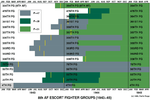CobberKane
Banned
- 706
- Apr 4, 2012
They trained the same way the Luftwaffe trained, Parsifal. "During the years leading up to the attack upon Pearl Harbor, some lessons for combat training were learned by the Japanese during the conflicts in Manchuria and China in 1931 and 1937, but the study of the German Air Force made by Yamashita, then Inspector General of Aviation, in 1940-41, undoubtedly formed the basis for much of the modern training program." Ibid., p. 54.
PS: The Luftwaffe program was shaken for much the same reasons, too, and at around the same time.
Sorry Oldskeptic, I just can't help myself. VB, there seems to be a guarded assertion going on that the Hellcats record in the ETO is applicable to comparing it to the contemporary Spitfire as an air to air weapon? Or not, if I'm reading something between the lines that isn't there. Are you concluding that the quality of Japanese fighter pilots from, say, late 1943 (when the Hellcat commenced it's heroics) was comparable to the Luftwaffe? If so, would you nominate some other strategical or tactical factor that explains the Hellcats much better kill loss ratio, or alternatively something about the Hellcat itself compared to the Spit?


